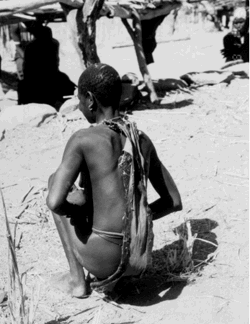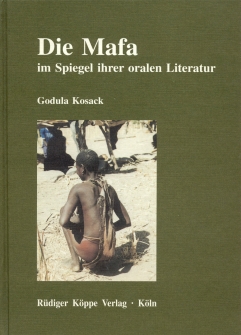



With approximately 200,000 members the Mafa are the largest and politically dominant ethnic group of the 14 ethnic groups which live in the northern Mandara Mountains in Northern Cameroon. The Mafa practice a subsistence economy and are sometimes still referred to as Matakam in the literature, a term which originates from the times of slavery and refers to “those who are easy to catch”.
The Mafa are a patrilinear society. Lineage is defined by the father. After marriage the women move onto their husband’s farmstead, a patrilocal living arrangement which requires the women to leave their own families and settle in new ones, those of their husbands. Here they are treated as strangers all their lives.
Between 1981 and 1997 the author lived with the Mafa for a total of 28 months. During this period of time she collected 157 narratives (fairy tales, fables, creation myths). The largest part of these, which are mostly told by women, are presented in this study. The Mafa regard their narratives as reports of events which have taken place in the form narrated or a similar one in the past. The tales deal with all aspects of life: birth, childhood, marriage, motherhood, work, belief systems, death, the afterlife. Even the “magical tales” are believed to be true. Magic, which is regarded as fantastical in Western rational thought, appears real to the Mafa.
The narratives tell about situations of conflict in which the protagonists or antagonists deviate from the respective social norms and demonstrate a rich spectrum of types of human behaviour. The culture provides the framework of possibilities and limits which determine an individual’s restrictions or opportunities for development.
No “innocent Ethiopians”, naïve savages, or exotic children of nature are depicted, rather human beings: guilty and innocent, naïve and sophisticated, wild and gentle, genuine and disfigured, as they are everywhere. The solutions presented do not only provide insight into the prevalent morals, but also show tolerance for deviating behaviour. Trickster-narratives, which form about one third of the oral literature of the Mafa, may be understood as didactic narratives.
The author based her in-depth interviews on the narratives. The male and female narrators simultaneously became informants. The topics of the interviews arose out of the tales; marriage, funerals, slavery, religious belief all play a role in the narratives. What the author always inquired about was the relation a tale had to the life of the people today.
The interpretations of the narrators and the examples from everyday life they associated with them are a further ethnographic source which has been made accessible by the author. The examples show what is specific for Mafa culture in the narratives as well as which motifs are discernible as generally African or even universal.
In further studies of our programme, the ethnohistorical roots of the Mandara peoples in northern Cameroon and northern Nigeria and the Biu-Mandara languages are focused, see the following links:
This monograph on the Mafa in Northern Cameroon includes the major chapters of a classical monograph, stressing the women’s perspective: childhood, being a bride, marriage, motherhood, the mother’s sister, the world of men (including gender relations, mutual dependence), death, the world beyond, and conclusions.
Kosack has lived with the Mafa for a long time, during several field trips with her husband and three children, and she includes self-reflexive accounts in her ethnography. An appendix includes a glossary of Mafa terms, the stories used in the book, the narrators (25 women, 11 men, and 219 interviewed women who have been cited in the monograph). Kosack has recorded more than 200 life histories of women. Thus she constructs an ideal-typical woman of the Mafa society, who from the first day is subject to customary social relationships which are based on values based on belief systems.
Belief systems are based on economy, the way of production – which has resulted from historical development. All of these processes emerge from people’s relations with each other and with environments – they are illustrated by and exemplified with 158 stories retold in German, with commentaries of interviewees and the authoress.
Ulrich Oberdiek in Anthropological Abstracts, www.anthropology-online.de/Aga04/0099.html, 141
Das vorliegende Buch, 1977 als Habililationsschrift in Marburg vorgelegt, ist ein wichtiger Beitrag zur afrikanistischen Erzählforschung. Die Ethnosoziologin Kosack verbrachte zwischen 1981 und 1997 insgesamt 28 Monate im Nordzipfel Kameruns südlich des Tschad-Sees unter den Mafa, einem ungefähr 200.000 Personen zählenden Bergvolk, das bis heute nur zu etwa 20% islamisiert bzw. christianisiert ist. Die Mafa leben von Feldbau und Viehwirtschaft und kennen keine zentrale politische Gewalt, sondern als höchste Autorität die einzelnen Hausherren. Die Autorin nahm unter ihnen 157 Geschichten von 25 Erzählerinnen und elf Erzählern auf, von denen die meisten in vollem Umfang im Buch verstreut wiedergegeben sind. Sie benutzte diese Geschichten als Ausgangspunkt für ihre Befragungen (219 Interviewte, hauptsächlich Frauen, mit Kurzbiographien im Anhang porträtiert), besprach einzelne Themen aus den Geschichten und bat um Stellungnahmen und um eigene Erfahrungen auf dem Gebiet. Die oft verblüffenden Aussagen ordnete sie nach den Abschnitten des Lebenslaufes einer Frau: Kindheit, Brautzeit, Ehe, Mutterschaft, Zeit nach dem Klimakterium, Tod; darüber hinaus stellt sie die Männerwelt aus Sicht der Frauen dar sowie die jenseitige Welt. Durch die häufigen wörtlichen Zitate (in deutscher Übersetzung) entsteht ein faszinierend lebendiges Bild, das desto mehr westliche, aber auch die meisten afrikanischen Leser erschüttert, weil es die Mafa-Frauen in einem heute kaum noch für möglich gehaltenen Abhängigkeitsverhältnis von den Männern schildert: Auf den Knien rutschend muß die Frau dem Mann einen Trunk Wasser reichen, kann von ihrem Vater einem sehr viel älteren Mann, der ihm auf dem Markt ein Bier spendiert, als Frau gegeben werden, hat kein Recht auf ihre Kinder.
Sigrid Schmidt in Fabula, 43/2002, 166-169
© 2026 by Rüdiger Köppe Verlag – www.koeppe.de